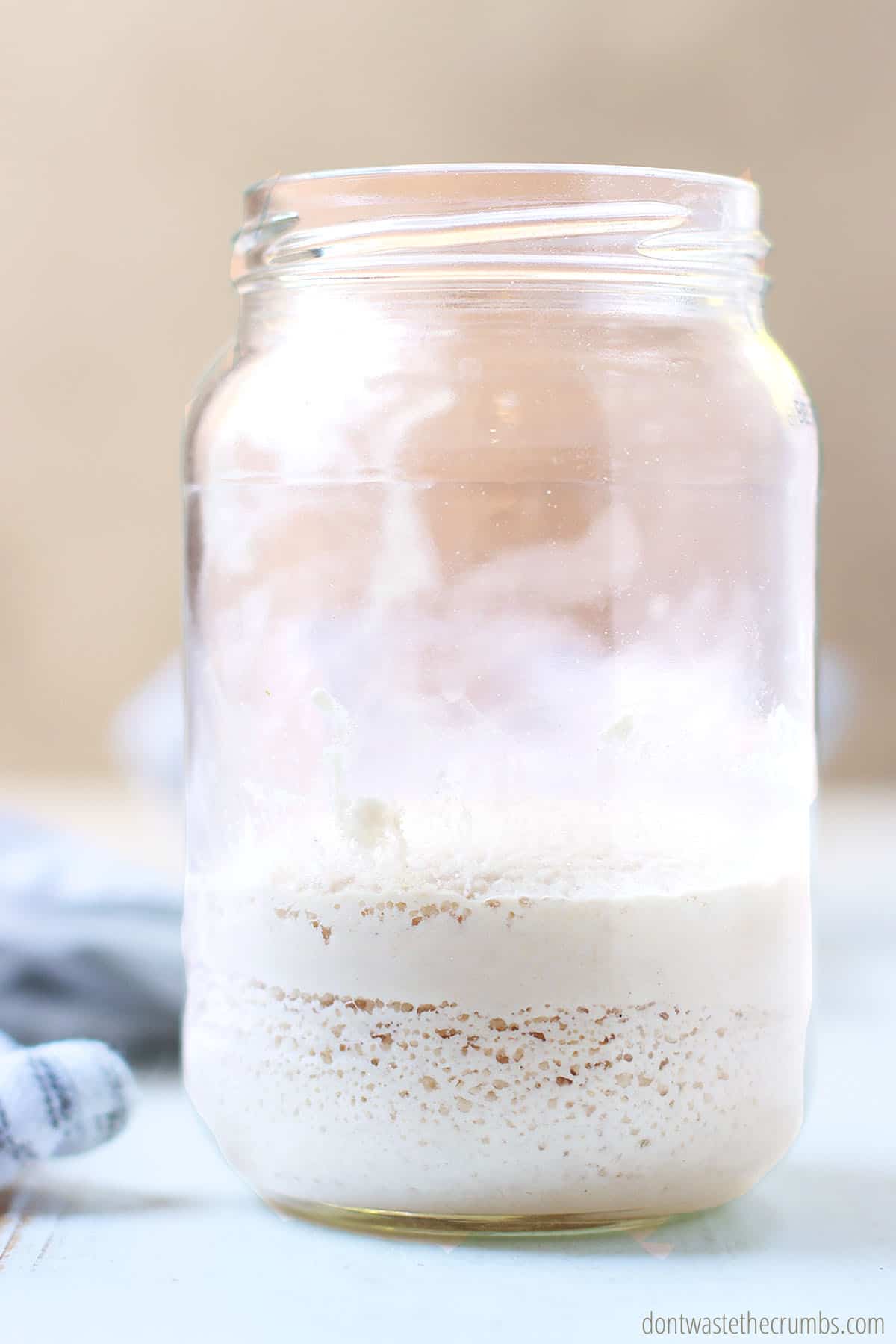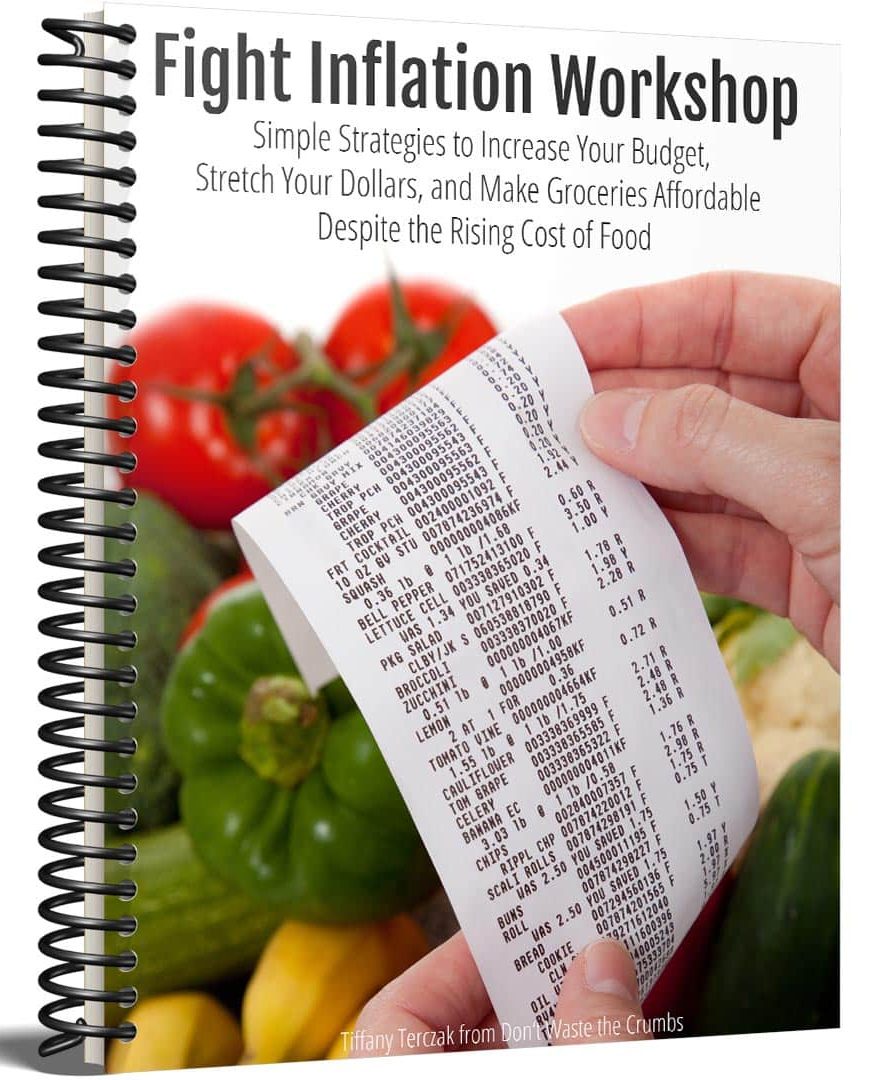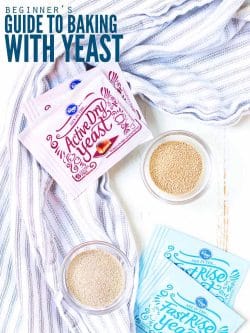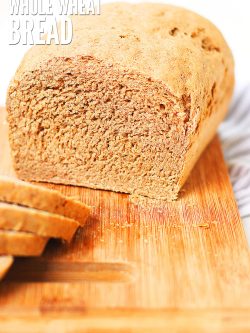This gluten-free sourdough starter, made with whole-grain brown rice flour, will give you the benefits of sourdough without the gluten. It’s easy to start, and it makes delicious sourdough baked goods!

You know there’s a great love for sourdough when people all across the real food arena unite in asking the same question:
Can you make a gluten-free sourdough starter?
1 in 5 Americans eats gluten-free for various reasons, so the question isn’t surprising. So, in an attempt to answer this question, there’s been another food project in my kitchen for the past 10 days. I’m trying yet again to capture wild yeast from thin air.
The consistency of my gluten free sourdough starter looks a lot like cream of wheat…you know, the breakfast cereal? But thinner (and smellier). It definitely doesn’t look like the “soupy flour” mixture from the ordinary sourdough starter.
In fact, just about everything was different about this gluten-free sourdough starter, except three things that stayed the same:
- It only required flour and water.
- Even with an extra feeding, it wasn’t much work.
- It was a success!
So, to answer the question, yes, my dear sweet gluten-free friends, you can!
Note: Be sure to read through the entire tutorial and additional recipe tips before starting your gluten-free sourdough.
INGREDIENTS FOR MAKING YOUR OWN GLUTEN-FREE SOURDOUGH STARTER
- brown rice flour
- cold (or room temperature) filtered water
Note: Chlorine or hard water can hinder the growth of your sourdough starter. Use filtered water to avoid those issues found in tap water.
Make sure to have a large bowl (approx. gallon-size) with a lid for the first week as you establish your gluten-free sourdough starter.

GLUTEN FREE SOURDOUGH STARTER RECIPE INSTRUCTIONS
Step 1. In a large bowl, combine ½ cup of flour with ½ cup of water and stir until all the lumps are gone. The mixture will be very thin and soupy. Lightly cover the bowl with a lid, leaving it cracked so that air can flow freely. If bugs and insects are an issue, you may cover the bowl with cheesecloth instead and secure it with a rubber band.
Step 2. Place the bowl in a warm area where it can sit undisturbed. This could be outside on a patio, on a kitchen counter, or in a pantry cabinet. Put it somewhere you can see it so that you remember to feed it!
Step 3. Every day, for the next seven days, feed the starter three times a day at approximately the same time. For best results, try to feed the starter at even intervals. For example, 6 am (or when you first wake up), 2 pm (just after lunch), and 10 pm (right before going to bed).
Step 4. At each feeding, feed the starter ½ cup of flour with enough water to mix thoroughly, usually ¼ to ½ cup, for a total of ¾ to 1 ½ cups of flour mixture each day. At each feeding, stir well, re-cover, and allow it to sit.
Step 5. The starter may or may not go through a bubbly stage and if it does, it may not be very noticeable. The starter may smell foul around days 2-4, very much like rotten eggs.
The smell is not an indication of contamination; rather, it is the natural smell of wild yeast combined with brown rice flour. The smell should subside and become pleasant by day 6-7.
Note: Once established, the gluten-free sourdough starter will go through a bubbly and frothy stage and eventually subside. The starter will smell like yeast and/or wine, but the smell should always be pleasant. If the starter ever smells sour or rancid, or if you see any white, orange, or pink film or mold, it has been contaminated and should be thrown away.

VISUAL PROCESS OF SOURDOUGH STARTER GLUTEN FREE
DAY 1
- This is what the starter looks like when it’s first mixed together and what it looked like after one full day of feeding. No noticeable changes.

DAY 2
- We have wild yeast! There are some large bubbles and some small bubbles visible through the side of the bowl.
- The surface will look like cracked clay. There may or may not be visible bubbles on the surface of the starter.

DAY 3
- Good news! The yeast is multiplying at an exponential rate. There are more of the larger bubbles and even more of the smaller bubbles.
- Again, the surface will look like cracked clay, and it may or may not have visible bubbles on the surface of the starter.
- You will notice that as you stir, the starter will lack the stringy, spongey feel that traditional sourdough has. This is normal. The starter may begin to have an odor. Keep feeding as directed.

DAYS 4-7
- The bubbles begin to become equal in size and evenly distributed throughout the starter.
- Odors should subside and the starter should smell like sweet yeast by day 7.
- Approximately 2-3 hours after feeding, the starter should reach its peak and create a dome on top.

FEEDING SOURDOUGH STARTER
Once the starter is officially created, it enters maintenance mode. The frequency you choose for feeding sourdough starter is determined by how much starter you need and how often you plan to use it.
- Once a week: At a minimum, the starter can be kept in the refrigerator and fed once a week merely to sustain the life of the captured wild yeast.
- Daily: You can continue to feed it daily as you have been, and in another seven days, there will be enough starter for another batch of bread.
- Smaller amounts: You can also feed your starter as little as one tablespoon of gluten free flour and water for every two cups of starter – enough to continue daily growth but not produce a large quantity of starter. (One quart of starter would be fed with two tablespoons).
However frequently or infrequently you decide to feed your starter, the yeast thrives best when it’s fed regularly and consistently. Choose your time frame and quantity and stick with it as best as you can.
PREPPING THE REFRIGERATED STARTER FOR BAKING
Yeast grows incredibly slow at refrigeration temperatures, which is why you can get away with feeding it only once a week. In order for the yeast to successfully leaven a batch of bread, it must be “revived”, so to speak.
The steps are below, along with an example to help you better understand the time frame involved.
- Three and a half days before you plan to bake bread, remove the starter from the fridge and allow it to come to room temperature. (Monday night)
- Once the starter is at room temperature, feed with equal parts flour and water. (Tuesday morning)
- Feed the starter two more times that day, around lunch and again before bed. (Tuesday afternoon and evening)
- On the morning of day three, feed the starter again. If the starter domes after 2-3 hours, you are ready to bake bread. If the starter does not dome, continue feeding three times daily until there is foam and liquid. (Wednesday morning)
ADDITIONAL GLUTEN-FREE SOURDOUGH STARTER TIPS
- One 22 oz package of brown rice flour is the exact amount needed for this recipe. If you want to continue to feed your starter brown rice flour after the first seven days, wish to have a greater quantity of starter after the first seven days, or want to use brown rice flour to bake with your starter, you will need at least two bags of flour.
- Excess liquid did not collect on the surface of this gluten-free starter. If yours does, you can pour it down the drain or stir it into the starter.
- If your starter outgrows your bowl, you may split it between two bowls. Continue the feeding process, dividing the flour and water between the bowls (¼ cup of each, for each bowl).
- If you are culturing other items simultaneously, be sure to leave at least 3-5 feet of space between each item so the yeasts do not cross-contaminate. (Sourdough won’t make your kefir “bad,” but both cultures can weaken over time. Best just to keep them apart.)
- Always allow a bit of room for expansion by discarding some starter and leaving approximately ½ cup of starter to feed. This ensures you have enough yeast to continue fermenting at the same pace you have been. We made sure to test this gluten free starter discard in gluten free sourdough pancakes, and they were good!
- With the time involved in “reviving” refrigerated sourdough, it’s often easier to keep the starter at room temperature and reduce the feedings to only a tablespoon or two daily.

GLUTEN FREE SOURDOUGH STARTER FAQS
What is the best flour to use for gluten-free sourdough starter?
In my opinion, the best flour for gluten-free sourdough is brown rice flour because it is a whole grain flour.
You may use white rice flour, but using brown rice will give you more nutrients. Other options include gluten free flours or a commercial gluten-free flour blend (like this one).
Is sourdough better for gluten intolerance?
Sourdough can be a good option for those with gluten intolerance, IBS, or gluten sensitivity. It contains a lower level of gluten.
Does sourdough bread have gluten?
Sourdough bread recipes made with wheat flour still has gluten, although it has a lower level of gluten. This gluten free sourdough starter contains brown rice flour instead, so it does not have gluten.
Can I throw leftover dough scraps back into my gluten-free sourdough starter?
While we don’t want to waste food, the dough tends to have other ingredients too, like salt, eggs, butter, etc. and that wouldn’t be a good environment for your starter.
Instead, freeze your dough scraps, and when you have enough, fry them up and coat them in cinnamon sugar for a homemade version of donuts.
MORE GLUTEN-FREE RECIPES
- Einkorn Pizza Dough
- Mini Chocolate Chip Scones
- Einkorn Coffee Cake
- Homemade Cassava Flour Tortillas (Gluten-free, Grain-free)
- Almond Crusted Chicken
- Healthy Thumbprint Cookies









When you feed your starter sour dough, do you mix it all together with old one, or mix it separate then just pour it on top ?
Hi Tiffany so I am not discarding and adding 1/2 cup of brown rice flour and 1/2 cup water 3 x day but seems a bit watery on second day maybe less water and okay not to discard you don’t mentioned discarding
Hi, I have been working on making this sourdough starter for a week now. I am using brown rice flour and started it monday night. It smelled rather unpleasant for a number of days. I actually had two jars going, one I discarded from and the other I did not. I noticed the one I discarded from was much stronger and bubblier than the other.. Eventually I wound up discarding both.. Anyway, I noticed the smell getting less and less strong with the feedings twice a day and it seemed so happy and bubbly.. Then I put them in the fridge after I fed them friday morning and Saturday night I took them out and fed them, only since then, both starters have not been growing nearly as much after each feeding and they both smell like plain yogurt. Does this mean that they are bad? It isn’t a bad yogurt smell… but, it is Monday and I have fed them 4 times now since taking them out of the fridge. They are getting some bubbles, but are not nearly as active as before going in the fridge. That, plus the yogurt smell are making me wonder if I need to start over? Or is the yogurt smell the smell I am looking for?
Hi Helen! Starters shouldn’t go in the fridge until they’re mature, which is at about 4 weeks. You don’t have to start over, and the yogurt smell is normal, but you might want to treat the starters like they’re new and continue to feed and discard. If you don’t see any improvement in about 4 days, then I’d start over.
Ok, thank you! So, if I shouldn’t put it in the fridge yet, what should I do if I can’t feed it for about 24 hours? That will only happen about once a week.. And, assuming the starter “comes back to life” what signs am I looking for before I can use it for bread and for discard recipes? Should the smell mature more?
Hi Tiffany, Is it possible to ferment rice flour with wheat flour sourdough starter? I already have a few years old wheat flour sourdough starter which I use for making sourdough bread. Thank you.
Really just q question. After a week, I clearly have some activity in my rice starter, but far less than my yeast starter. I also note that there is a fair amount of Hooch off throw. Unless the activity picks up, I doubt it will raise a loaf of bread. What so you think? Keep feeding, or toss it and start over?
If it doesn’t smell bad Jack, I’d keep going. Lots of things can effect how quickly a start grows, including whether or not it has gluten and temperatures. If your house is on the cooler side this time of year, the starter will naturally grow slower. Starting over won’t speed up the process, so I’d just keep going and use excess starter in pancakes or biscuits!
will this have a stringy/spongy quality in the end like regular flour for sourdough?
I’m new to making sourdough. So the starter is actually not the “dough”? I have to add the starter to the flour? I wonder if the starter could be used with almond flour? I haven’t been able to find such recipes
Hi Sara! Correct, the starter is not the dough. I would not recommend using almond flour in sourdough. It behaves VERY differently than grains do, and it likely would not work (which would explain why you haven’t found any recipes using it!).
I have a traditional sourdough starter that I use for my husband and friends (sourdough waffles are the BEST!!!). I found out 2 yrs ago that I am gluten intolerant because of Hashimotos, but also can’t have rice, soy, corn, etc. I have just made a sourdough starter for me that has sourgum, teff, millet, quinoa and amaranth flours in it. This is my bread flour and I can make a very good sandwich bread and rolls with it. But I miss sourdough. I have to feed my starter for a few more days and then I will cook with it.
Something I did differently than you did…I learned some years ago that you can take any dark, edible berry that has the light coating on it (bloom) and throw a small handful in your flour/water mix to help introduce good bacteria. So I have done that. I did it to make my husband’s sourdough with wheat flour. You fish out the berries after a couple of days. It works great.
Now I will be looking for recipes to make bread, pancakes and biscuits.
Once I finished the 7 day starter, can I reduced it to 2c and just keep it on my counter and add 1 tbsp flour and water to it once a day? Will that be enough starter to make a loaf once or twice a week? Since the recipe for the bread only calls for 1/2c starter? Or can I keep it in the fridge and feed it the 1 tbls flour and water once a week? You didn’t talk a ton about after you make the starter. I have no experience with sour dough starters! Thank you!
The least amount of flour I’ve seen used to feed starters is 1/4 cup. If you want to make bread once or twice a week, you’ll need to feed daily. You can feed weekly if you keep it in the fridge though!
Anyone try this with almond flour? Would it work?
I haven’t Heather, but odds are it won’t work.
Hi tiffany, I’ve been baking tradational sourdough for a while now, but I’m branching out into gf sourdough as my daughter and partner are coeliac.
I started this gf starter the way you have written, got to day 5 everything was going just great, today is day 7 and all action has stopped and not smelling to good. For your interest and for other people I had to get rid of some on day 3 and 5 as it was getting a bit much I left 2 cups of starter to keep it going.
I’ll be starting from scratch again and fingers crossed it works out this time. Thank you for your time.
Hi Tiffany, I am very excited about my starter that I created 4 days ago, but quick question about trouble shooting, mine is getting liquid on top and it’s a different colour to the starter. What would indicate bad growth/bad bacteria? Is a colour change in the liquid bad? It’s a bit pink coloured compared to the beige starter
Hi Michelle! I’m not an expert in sourdough, but as long as it smells good, I think you’re okay!
Thank you, it’s starting to smell lovely like Sweet yeast and it’s only day 5 😀
Just a quick question. Do i feed it with half a cup of flour at each feed 3 x a day so 1.5cups in total a day or half a cup for the entire day?
Rebecca – it’s 1/2 cup at each feeding. I’ll update the post to clarify this!